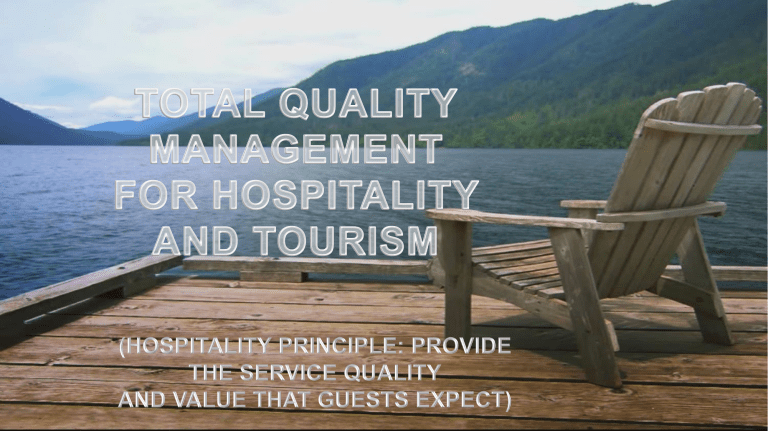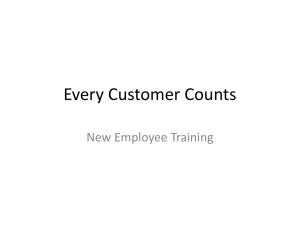
Learning Objectives 1. After reading this chapter, you should understand: Important differences between making products and serving guests. The importance of meeting the hospitality guest’s expectations. The importance of the guest experience. The components of the guest experience. The definition of service quality and service value in the hospitality field. The reasons why “it all starts with the guest.” Two Main Groups of People Involved in Hospitality and Tourism GUESTS (Customers) + HOSTS (Employees) Total Quality Management (TQM) A process designed to cut down on an organization’s “defects,” to determine its customer requirements, and to satisfy these requirements. TQM’s key principles are: 1. 2. 3. 4. 5. Commitment to quality Focus on customer satisfaction Assessment of organizational culture Empowerment of employees and teams Measurement of quality efforts TQM Benefits of Customer Codes and Guarantees Communicate to guests what to expect in the service delivery. Give the organization’s employees a clear idea of what is expected of them in serving guests. May also articulate what the organization will do for the guest if the service delivery is not satisfactory. Employee Selection, Orientation, Training, and Motivation Managing “internal customers” Staff selection Orientation Training Motivating and retaining Empowering Empowering Employees Giving employees the authority to identify and solve guest problems or complaints “on the spot,” and to make improvements in work processes when necessary Decentralizing decision-making or “flattening” the organization chart. Having greater trust in subordinates and their judgments Fourteen Principles of Hospitality Management The Hospitality Service Strategy 1. Provide the service quality and value that guests expect. 2. Focus strategy on the key drivers of guest satisfaction 3. Provide the service setting that guests expect 4. Define and sustain a total service culture The Hospitality Service Staff 5. 6. 7. 8. Find and hire people who love to serve Train your employees, then train them some more Motivate and empower your employees Empower guests to co-create their experiences The Hospitality Service Systems 9. Glue the guest experience elements together with information 10.Provide seamless service delivery 11.Manage the guest’s wait 12.Pursue perfection relentlessly 13.Don’t fail the guest twice 14.Lead others to excel SERVQUAL – Standing for “service quality” SERVQUAL is the best-known survey instrument within the service field; measures customer perceptions of service quality along five dimensions: reliability, responsiveness, assurance, empathy, and tangibles SERVQUAL Model Dimensions 1. Tangibles (physical facilities, equipment, staff appearance). 2. Reliability (ability to perform the service dependably and accurately). 3. Responsiveness (willingness to help customers and to respond promptly). 4. Assurance (knowledge/courtesy of staff and ability to portray trust and confidence). 5. Empathy (degree of caring, individualized service). The Basics of Wow! The Guest Knows Best KEY TERMS AND CONCEPTS Benchmark Organization – Organizations that meet and often exceed customer expectations regarding service quality and value and that have a high degree of excellence in their services, processes, and business support systems; these organizations also frequently have a world-class reputation Cost – the entire burden expended by a guest to receive a service, including tangible quantifiable costs (like price) and intangible nonquantifiable costs like the opportunity costs of foregoing alternative opportunities, annoyance at receiving unsatisfactory service, and so forth. Critical Incident – A significant or memorable interaction point between organization and guest. Expectations – Characteristics that guests hope and assume will be associated with a service experience which drive their evaluation of the quality and value of the service experience. Guest experience – Defined as consisting of the service product, setting, and delivery system, it is the sum total of the experience that the guest has with the service provider on a given occasion or set of occasions; often referred to as service experience in other countries. Guestologist – A specialist in identifying how hospitality organizations can best respond to the needs, wants, and expectations of their targeted guest markets. Guestology – the study of guests and their behavior their wants, needs, and expectations with the aim of aligning the organization’s strategy, staff and systems so as to provide outstanding service to guests. Hospitality – An industry consisting basically of organizations that offer guests courteous professional food, drink and lodging services, alone or in combination, but in an expanded definition also including theme park, gaming, cruise ship, trade show, fair, meeting planning, and convention organizations. Internal customers – persons or units within the organization that depend on and serve each other. KSAs – Short for knowledge, skills, and abilities necessary to do a job. Moment of truth – A term coined by Jan Carlzon to refer to any key or crucial moment or period during a service encounter, a make-or-break moment ; subsequently expanded by others to include any significant or memorable interaction point between organization and guest. Quality – Special meaning in the services field: the difference between what the guest expects and what the guest gets. Service – An action or performed task that takes place by direct contact between the customer or guest and representatives of the service organization which can be provided by a person or via technology. Service delivery – The process though which the service product is provided to the customer. Service delivery system – The human components and the physical production processes, plus the organizational and information systems, involved in delivering the service to the customer. Service encounter – The actual personto-person interaction or series of interaction between the customer and the persons delivering the service. Service environment – The physical location and its characteristics within which the organization provides service to guests; same as service setting and servicescape Service product – The entire bundle of tangibles and intangibles provided by a hospitality organization to guests during a service experience Service quality – Special meaning in the services field: the difference between the service that the customer expects to get and the service that the customer actually receives Service setting – The physical location and its characteristics within which the organization provides service to guests Service value – The relationship of the quality of the service to its cost, or service quality divided by the cost of service Value – Quality related to cost, or quality divided by cost. Values – Preferences for certain ideas, behaviors, and outcomes over others, used and promulgated within organizations to define for members (and sometimes guests) what is right and wrong. Preferred and not preferred. LESSONS LEARNED 1. Treat each customer like a guest, and always start with the guest. 2. Your guest defines the value and the quality of your service, so you had better know what your guest wants. 3. Ask, ask, ask your guests. 4. Provide memorable experiences that exceed guest expectations when possible, but know when enough is enough; deliver more than the guest expects, but not more than the guest wants. 5. Manage all three parts of the guest experience: the service product, the service environment, and the service delivery system (both the processes and the people). 6. The less tangible the guest experience, the more important are the frontline people delivering the service to the guest’s perception of quality and value. 7. You may under-promise, but always try to over-deliver. 8. The cost of providing quality is low compared to the potential cost of not providing quality. 9. Service product + service environment + service delivery system = guest experience 10.Experiences that evoke a guest’s emotions are more memorable.
